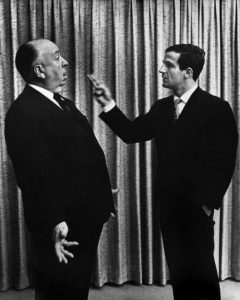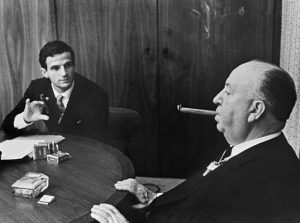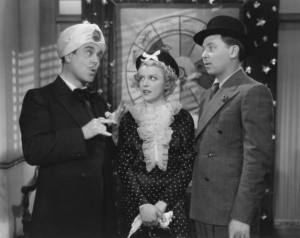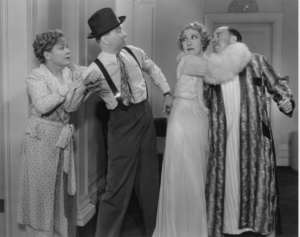Star Wars Light Saber Battles
Posted on December 16, 2015 at 11:46 am
Data curated by PrettyFamous
Posted on December 15, 2015 at 3:36 pm

If you are very lucky, some day a book will change your life. And no book changed my life more profoundly than Hitchcock/Truffaut, a book-length interview of one of the world’s greatest movie directors by another who happened to be a former film critic and scholar. I was a movie-mad teenager when someone suggested this book to me, and it completely transformed the way I watched and thought about movies. So I was thrilled to see the wonderful new documentary “Hitchcock/Truffaut” by film critic/historian Kent Jones, with some of today’s greatest directors talking about how the book and Hitchcock’s work influenced and inspired them.
In an interview, Jones talked about his choice for the movie’s narrator, actor/director/screenwriter Bob Balaban. “I wanted only filmmakers in the movie. I didn’t want any experts or historians or actors or anything like that. I just wanted filmmakers because it was a dialogue between filmmakers. And so I wanted ideally somebody who was a filmmaker as well to be the narrator and Bob of course you know in addition to being an actor and director of movies and beyond that Bob also was Truffaut’s friend. They became good friends when they made ‘Close Encounter of the Third Kind,’ so for all those reasons and also I like Bob and I like his voice.”
The documentary includes some scenes with the translator who worked with the two men because their only real common language was the language of cinema. “It’s interesting, there’s a good rapport between the two of them and you could say between the three of them because she is very much a part of the conversation, in and of itself. There are moments when she and Hitchcock are talking. She was really attached to Truffaut as a friend, as a filmmaker, someone who was really smitten with him as a human being. But I don’t think that it really impeded the flow, I mean they had a good rapport. They were both filmmakers and the trends of the conversation were very clear. On the other hand there’s a lot of stuff that she gets wrong, like the names of certain film producers for instance when they were trying to talk about what movies he’s seen and what he hadn’t seen when he was young. There are different titles in different countries so try to figure out what movie it they were talking about was a little bit of a challenge. I think also Hitchcock understood French, he actually spoke it. But nonetheless throughout the tape, even in the movie when he’s talking about vertigo he doesn’t say ‘necrophilia’ he says ‘necrophilie’. You know he inserts a little French pronunciation. Truffaut on the other and really didn’t understand English but having said all that I think the flow of their conversation is pretty seamless.”
While Hitchcock was still dismissed as a genre director in the US of the 1960’s, the French “new wave” filmmakers and critics were the first to take him seriously as a master of cinematic storytelling. “What we call ‘auteurism’ now is very tied into the distance of time and the distance of space. It is very important that it was a group of people from across the Atlantic looking at America through different lens, looking at American filmmaking through their own lens. Obviously Hitchcock wasn’t alone, Nick Ray, Howard Hawks and all these people. Even people who say ‘I hate auteurism; it’s ridiculous’ when they write their reviews nonetheless they’ll refer to Michael Bay’s ‘Transformers 4.’ I mean they don’t know it but they have been transformed by the idea. And so I think that’s always a great thing when somebody gets people to accept something in a new light and gives people a new way of seeing the work that they thought that they knew. I think that that’s a great thing and it’s just really fruitful in this case, it just kind of opened the door to a really exalted idea in cinema.”

We agreed that the Montgomery Clift film, “I Confess” is one of Hitchcock’s underrated gems. Clift plays a priest who learns of a murder in confession and then himself becomes a suspect but cannot reveal what he has heard. “I love ‘I Confess.’ I think it’s great. Maybe you could say that in some of those 50’s movie things get a little telescoped at the very, very end. I really love the atmosphere of it, I love Clift, I love the presence of Québec City in the movie. I thought that those flashbacks were incredibly beautiful. It’s the film that my mother loved.” Jones objects to some of the conventional wisdom that Hitchcock did not work well with actors. He spoke about the special relationship Hitchcock had with Grace Kelly, James Stewart, and Cary Grant, who gave some of their best performances in his films. “Doris Day gives her most interesting and vulnerable performance in ‘The Man Who Knew Too Much,’ better than in ‘Love Me or Leave Me’ just riveting.”
Jones was reluctant to pick a favorite Hitchcock film because he likes to look at it as a body of work. “Within the history of Hollywood studio system of filmmaking, that’s the best body of work there is bar none. I mean the only body of work that I can think of that is kind of like it in terms of somebody working into the studio system where every film is as good is Yasujirō Ozu. There is no movie that he ever made that was at second gear, ever. And having said that I don’t know, I could narrow it down to about 10 or 12 or something maybe ‘Notorious’ or ‘Vertigo’ or ‘Rear Window.’ I don’t know it’s impossible for me.”
Posted on December 8, 2015 at 3:50 pm
Cameron is The Blonde at the Film, and her blog on vintage movie classics is one of my favorites. I especially love the History Through Hollywood series where she traces technology and culture as portrayed over the years in films. Ever wondered about how everyone in old movies drinks cocktails? Or why old-time phone numbers began with words instead of numbers? Her explanations are lively and informative.

I am very grateful to Cameron for taking time to answer my questions and I look forward to keeping up with her blog.
Has the availability of old films via Netflix, TCM, and other outlets widened the audience for vintage movies?
I definitely think so! Old films are more available now than ever, which is wonderful. TCM has been especially instrumental in reviving interest in old movies, and I use a great site called ClassicFlix.com that stocks just about anything you might want to rent. Although Netflix doesn’t have a huge selection, their streaming service has helped introduce people to classic movies. For example, a lot of my readers first find my site because they search for some variation of “classic movies to stream on Netflix” and land on my “Netflix Instant: Five Classic Films” posts.
Blogs and social media outlets like tumblr and pinterest have also helped spike interest in these classic films and stars. There is a thriving community of classic movie fans online, and it’s great that people are interested and that these films are so accessible today.
Do you have an example of a movie that was popular when it came out but has not stood the test of time? What about one that was neglected on its release but now is appreciated by audiences?
I immediately think of Esther Williams, a national champion swimmer who was discovered by MGM when she was performing in the Aquacade, a live water extravaganza. She became a huge star, and her films were incredibly popular for over a decade, but today she’s not nearly as well known as some of her contemporaries. Her movies are big Technicolor musicals with lavishly produced “water ballets,” and although I still find them delightful, audience tastes have changed quite a bit from Williams’ heyday. Films like Neptune’s Daughter (1949) or Easy to Love (1953) made MGM a healthy profit, but they aren’t as timeless as other classics.
A famous flop-turned-classic is Bringing Up Baby (1938), which is one of my favorites. It stars legends Katharine Hepburn and Cary Grant, and was directed by Howard Hawks, but when it was released, audiences weren’t nearly as enamored with it as people are today. For one thing, Hepburn had recently been named “box office poison,” and she wasn’t bringing in the crowds at that point in her career. But its lackluster performance was also due to its over-the-top wackiness. Its one of the most “screwball” of all the screwball comedies, so if you expect the characters to make rational sense, you’ll be disappointed. But if you embrace the crazy, you’ll probably have a great time. Fortunately, it’s now adored as the screwball masterpiece it is.
How did you begin to get interested in old movies and which were the ones you first loved?
We didn’t watch much TV when I was little, but my parents would take me to the public library and let me check out VHS tapes of old movies. I don’t know why, but I was hooked immediately. I first fell for 1950s musicals like Singin’ in the Rain (1952) and Seven Brides for Seven Brothers (1954), but I watched anything I could find. And at the time, there wasn’t much! I exhausted the library’s collection and my local video store’s “Classic” section, and became a Turner Classic Movies addict. I also read everything I could find about classic Hollywood, and the more I learned and watched, the more fascinated I became.
I find that it is immediately obvious when you are watching a film whether it was made in the 1930’s or 40’s or 50’s or made later and depicts an earlier era. Do you agree? What are the giveaways?
I absolutely agree. I think that no matter how hard we try, the current age sneaks in. You can see that happening in the classic era, too—for example, in The Harvey Girls (1946), which is set in the 1880s, Judy Garland and the other actresses sport 1940s hairstyles and makeup. Today we prize historical accuracy far more than they did in the studio era, but it’s still impossible to be perfect. If a filmmaker went for complete accuracy, the movie might become cartoonish or odd just because styles, fashion, architecture, language, etc., have changed so much. Also, the technology is so different; sound, color design, special effects, and other elements make movies look and sound differently depending on when they were made. In the 1940s, for instance, Technicolor films often featured a bright, saturated, bold palette with plenty of hot pinks, cyan, and chartreuse, but you don’t see that look today, even in films set in the 1940s. Part of this disjuncture is because movies don’t present “reality”—and especially not in the studio era! But that’s one reason I love old movies so much. When you watch one, especially a musical, you’re watching a dream world, not real life. But you can learn a lot about how people lived and what they enjoyed watching from the vision that movies presented. But don’t always trust their version of historical events!
How did you get interested in tracing technology and culture by watching old movies?
I can remember being confused by a lot of what I saw in old movies when I first started watching them as a kid. The clothes, homes, telephones, cars, and even the language seemed incredibly foreign. I didn’t understand why women were traveling to Reno to get divorced, or why American characters spoke in British accents, for example. But those disconnects fascinated me. After all, these are the films my grandparents went to see in theaters! I’m not that far removed from that era, but the world onscreen looks so different! As I continued watching I realized I was accidentally picking up a lot of information about things like fashion, courtship, travel, and even doughnuts.
Old movies are a great way to learn about the past, and I love writing about that in my “History Through Hollywood” series. I think of classic movies as inadvertent time capsules, packed with little details that find their way into films just because they were a normal part of life. It’s really interesting to me to learn why characters drink champagne out of shallow-bowled coupes instead of flutes, for instance, or why telephone numbers included words until the 1960s.
And sometimes what is left out of movies can tell you a lot, too. Our rating system only dates from 1968, and before that, the Production Code Administration, which was Hollywood’s self-censorship body, governed what could and could not be onscreen from 1934 until the 1960s. The Code was designed to keep anything “objectionable” out of the movies, and covered broad topics like violence and sex, but also stretched to tiny details such as how many seconds a kiss could last or the use of specific words. (The Code helped make classic movies a great option for kids today.) It’s important to remember that sometimes old movies do not necessarily reflect the reality of the time, but instead show the power of the Code and an era’s social mores and values.
I also try to make old films more accessible and watchable, so I like to provide context and explain why these movies seem “tame” or different from today’s films. I think that if a viewer comes to them cold, he or she can get confused, bored, or just find the movies silly because the world onscreen can seem really foreign. I hope that by tracing cultural and technological change, and trying to explain why an old movie looks and sounds the way it does, viewers who are new to classic films might enjoy them even more.
If you could keep one aspect of early telephone technology, what would it be?
There isn’t anything quite as glamorous as a gorgeous, sculpted white handset in the perfectly manicured hand of a legendary star! And although I love the convenience of my smartphone, it might be fun to rely on an operator once in a while!
Posted on November 14, 2015 at 3:53 pm
I’m sorry Sandra Bullock’s film, Our Brand is Crisis, isn’t getting more attention. I thought it was smart and funny and loved Bullock’s performance. But I admit another reason I liked it was that the wonderful actress Ann Dowd played a character who shares my first name, Nell.
I often joke that my parents collect antiques, starting with the names they gave their daughters. I love my name — it is simple but rare. It has literary connections thanks to Charles Dickens, and musical connections, especially if you’re in a barbershop quartet. And I’m happy to share my name with my friend, the brilliant writer/director Nell Scovell, and with Nell Carter and Charles II’s famous love, Nell Gwynn.
Here are my other favorite movie Nells.
1. Debbie Reynolds in “The Gazebo.”
2. Jodie Foster in “Nell”
3. Julie Harris in “The Haunting”
4. Sarah Jessica Parker in “Dudley Do-Right” (I vastly prefer the original television series but have to mention SJP)
5. Eva Marie Saint in “Raintree County” (Elizabeth Taylor has the flashy role, but Eva Marie Saint as Nell is the woman whose love for Montgomery Clift provides him with some stability and peace.)
6. Marilyn Monroe in “Don’t Bother to Knock”
Posted on November 10, 2015 at 3:17 pm

A column by Michael Hiltzik in the LA Times about 700 “lost” Paramount films caught my attention. The first paragraph mentioned one of my favorite movies, “Alias Nick Beal,” with Ray Milland as Satan bargaining for the soul of a politician played by “Gone With the Wind’s” Thomas Mitchell. And then it mentioned a film I’d never heard of, written by one of my all-time favorite screenwriters (and later a director as well), Preston Sturges, a master of wisecracking screwball comedy (“The Lady Eve,” “Sullivan’s Travels,” “The Miracle of Morgan’s Creek”).
The film is “Hotel Haywire,” originally written for Burns and Allen, and then rewritten when they were not available. It was directed by Arthur Archainbaud, apparently his only credited film.

Fortunately, I live just outside of Washington, DC, which means that the Library of Congress is practically my neighborhood library. I love their Motion Picture and Television Reading Room, which has the nicest and most knowledgeable staff any movie lover could ever hope for. They have been inestimably helpful to me many times. It took them about ten minutes to track down the film at their Culpepper, Virginia storage facility and arrange for it to be brought in for me to watch.
It’s not a classic, but it was a lot of fun, partly because it was a rare lead role for Spring Byington, who usually played the mother of the main character (“Little Women”). In this, she plays the wife of a dentist (Lynne Overman) who is very caught up in spiritualism and horoscopes, as practiced by a charleton known as Dr. Zodiac Z. Zippe (Leo Carrillo). The dentist plays a prank on a friend by slipping a frilly camisole into his pocket, but the friend outsmarts him and puts it in the dentist’s pocket instead. When the wife finds it, instead of asking him about it she consults Dr. Zippe, who ends up advising both husband and wife in a manner that creates as much chaos as possible, especially after he hires some out-of-work vaudevillians as his “detectives.” Oh, and there’s also the dentist’s daughter, who wants to marry her boss’ son. And it all ends up in some door-slamming, who’s in what room shenanigans in a haywire hotel.
I hope this film, and the other 699 Hiltzik wrote about, will all be available soon, via streaming or DVD. Until then, we have the Library of Congress, and I will try them on another lost gem soon.